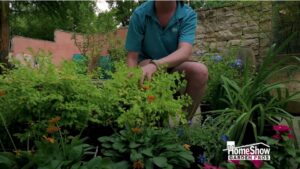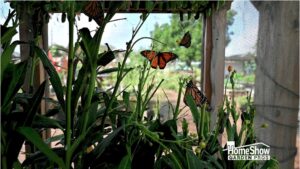Houston Organic Garden Tips & Advice
How To Properly Transplant a Plant In A New Pot
Transcript:
Sandie Moger:
Hi, I am Sandie.
Sherri Harrah:
And I’m Sherri, with HomeShow Garden Pros.
Sandie Moger:
And we are here with Ian from Nature’s Way Resources. And Ian, what do you have for us here this morning?
Ian Ferguson:
I want to show you how to transplant pretty much any type of plant into a larger pot, go through the proper steps, and then mulch afterwards.
Sandie Moger:
Okay. All right, well, teach me how to get this transplanted.
Ian Ferguson:
Okay, so the first thing you want to do, first know what you’re planting into. If you have a larger pot, figure out what that is and make sure you have enough soil in the bottom so your plant doesn’t sit too low.
Sandie Moger:
Okay, what-
Sherri Harrah:
So they’ve already put some soil in here.
Ian Ferguson:
Correct. This is our garden and flowerbed mix. It’s a pre-made mixture. It’s good for all applications, very generic mix for pretty much everything.
Sandie Moger:
Good. Okay.
Ian Ferguson:
So that’s the first step you want to do. Then the next thing you want to do when you get your plant, squeeze all four sides of the container, or if you have a round one, yeah, you want to break everything loose so it’s not stuck to the sides.
Sandie Moger:
Okay. It’s ready to pop out, kind of.
Sherri Harrah:
It kind of releases it, just in case it’s root-bound.
Ian Ferguson:
Yeah, exactly.
Sandie Moger:
All right.
Ian Ferguson:
The next thing you want to do is make sure you get the plant and put it between your fingers, so when you flip it over to take the pot off, it’s properly supported.
Sandie Moger:
Okay.
Ian Ferguson:
Exactly.
Sandie Moger:
All right.
Ian Ferguson:
Now look at the bottom. You always want to break the bottom up a little bit in case it’s root-bound. If it is root-bound, that’ll let the roots kind of hang freely and promote root growth into the deeper layers of soil.
Sandie Moger:
Okay.
Sherri Harrah:
Yeah, and this one’s not too root-bound. Sometimes you get them where it’s really wound up [inaudible 00:01:17]
Sandie Moger:
Okay.
Ian Ferguson:
Yeah, we lucked out on this one, for sure.
Sherri Harrah:
Yeah. Yeah.
Sandie Moger:
Okay. So is that enough?
Ian Ferguson:
Yeah, that looks good.
Sandie Moger:
Okay. So I’m going to get that down in there a little bit.
Ian Ferguson:
And then we want to backfill around the pot and everything.
Sherri Harrah:
Yeah, and you leveled it perfectly here, Sandie.
Sandie Moger:
Oh, wow. Okay.
Sherri Harrah:
So, just backfill all around the sides.
Sandie Moger:
Okay.
Ian Ferguson:
And lightly pack it in, just to make sure you have good contact between your plant and the existing soil.
Sandie Moger:
All right. Okay, so now do I push it down in there or kind of just leave it?
Ian Ferguson:
Yeah, very lightly around the sides.
Sandie Moger:
Okay.
Ian Ferguson:
Just kind of pack it in, make sure-
Sandie Moger:
All right.
Ian Ferguson:
… everything’s nice and stable.
Sandie Moger:
So there’s potting soil kind of all around it-
Sherri Harrah:
Mm-hmm.
Sandie Moger:
… a little space above.
Sherri Harrah:
Maybe a little more over here.
Sandie Moger:
A little more over here.
Sherri Harrah:
Yeah.
Ian Ferguson:
Now you’re looking good so far.
Sandie Moger:
All right. So now what?
Ian Ferguson:
So now that we have our potting soil or our mixture in, you have a little bit of space on the top and that is for the mulch. You want to add mulch because that’s good for water retention and weed suppression. And we always recommend to do it about two inches thick. It’s going to be a little difficult on a pot, so as thick as we can get it.
Sandie Moger:
Okay.
Sherri Harrah:
Yeah, especially because pots dry out faster, so it’s kind of a little hint to keep your pots good in the summertime here.
Ian Ferguson:
Oh, that’s definitely correct.
Sherri Harrah:
Put a little bit of mulch on top.
Sandie Moger:
So is mulch something that I would add occasionally to my potted plants, or-
Ian Ferguson:
Yeah, as needed, maybe once or twice a year, depending on how fast it decomposes.
Sandie Moger:
Okay.
Ian Ferguson:
It will obviously continue to break down as it sits in the pot longer and it gets more water.
Sandie Moger:
All right.
Sherri Harrah:
And it’s kind of the icing on the cake, right?
Sandie Moger:
Right.
Ian Ferguson:
Yeah. It’s like a little top dressing, it makes it look nice.
Sherri Harrah:
Yeah.
Sandie Moger:
It does. It does. So we had our potting soil, and we added a layer of mulch on the top, and voila, we have a beautiful potted plant.
Ian Ferguson:
That’s true. And the last step would just to be water it in. Make sure we do a deep, infrequent watering.
Sherri Harrah:
Yep.
Ian Ferguson:
That’s more advantageous for root growth.
Sandie Moger:
Okay.
Sherri Harrah:
Yep.
Sandie Moger:
And keep an eye on them, whether or not they’re inside or outside potted plant.
Ian Ferguson:
Oh, that’s definitely true. Inside plants require a lot less water, just it’s not as hot.
Sandie Moger:
Right.
Ian Ferguson:
Then outside, it’s exposed to the sun and the elements, so you’d probably water a little more often.
Sherri Harrah:
Yeah. And the size of the pot, too. Bigger pots, you don’t have to water as much.
Ian Ferguson:
Oh, that’s very true.
Sherri Harrah:
Yeah. Yeah.
Sandie Moger:
Good. Good. Well, all great tips. And you can hear more tips on HomeShow Garden Pros every Saturday morning.



